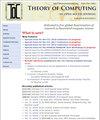IF 0.7
4区 计算机科学
Q4 COMPUTER SCIENCE, THEORY & METHODS
引用次数: 0
Abstract
$ $ A community of $n$ individuals splits into two camps, Red and Blue. The individuals are connected by a social network, which influences their colors. Every day each person changes their color according to the majority of their neighbors. Red (Blue) wins if everyone in the community becomes Red (Blue) at some point. We study this process when the underlying network is the random Erdős--Rényi graph $G(n, p)$. With a balanced initial state ($n/2$ persons in each camp), it is clear that each color wins with the same probability. Our study reveals that for any constants $p$ and $\varepsilon$, there is a constant $c$ such that if one camp has at least $n/2 + c$ individuals at the initial state, then it wins with probability at least $1 - \varepsilon$. The surprising fact here is that $c$ does not depend on $n$, the population of the community. When $p=1/2$ and $\varepsilon =.1$, one can set $c=5$, meaning one camp has $n/2 + 5$ members initially. In other words, it takes only $5$ extra people to win an election with overwhelming odds. We also generalize the result to $p = p_n = \text{o}(1)$ in a separate paper. ----------------- A preliminary version of this paper appeared in the Proceedings of the 24th International Conference on Randomization and Computation (RANDOM'20).$ $ $一个由$ $ $个人组成的社区分裂成两个阵营,红派和蓝派。个体通过社会网络联系在一起,这影响了他们的颜色。每天,每个人都会根据他们邻居的大多数人改变自己的颜色。如果社区中的每个人都变成了红(蓝),红(蓝)就会获胜。我们研究这个过程时,底层网络是随机的Erdős- r图$G(n, p)$。有了平衡的初始状态(每个阵营中有$n/2$人),很明显每种颜色都以相同的概率获胜。我们的研究表明,对于任意常数$p$和$\varepsilon$,存在一个常数$c$,使得如果一个阵营在初始状态下至少有$n/2 + c$个体,那么它以至少$1 - $ varepsilon$的概率获胜。这里令人惊讶的事实是,$c$并不依赖于$n$,即社区的人口。当$p=1/2$和$\varepsilon =。1$,我们可以设置$c=5$,这意味着一个阵营最初有$n/2 + 5$成员。换句话说,只需要额外的5美元,就可以赢得一场压倒性的选举。在另一篇论文中,我们也将结果推广到$p = p_n = \text{o}(1)$。-----------------这篇论文的初步版本发表在第24届随机化与计算国际会议论文集(RANDOM'20)上。
本文章由计算机程序翻译,如有差异,请以英文原文为准。
求助全文
约1分钟内获得全文
求助全文
来源期刊

Theory of Computing
Computer Science-Computational Theory and Mathematics
CiteScore
2.60
自引率
10.00%
发文量
23
期刊介绍:
"Theory of Computing" (ToC) is an online journal dedicated to the widest dissemination, free of charge, of research papers in theoretical computer science.
The journal does not differ from the best existing periodicals in its commitment to and method of peer review to ensure the highest quality. The scientific content of ToC is guaranteed by a world-class editorial board.
 求助内容:
求助内容: 应助结果提醒方式:
应助结果提醒方式:


